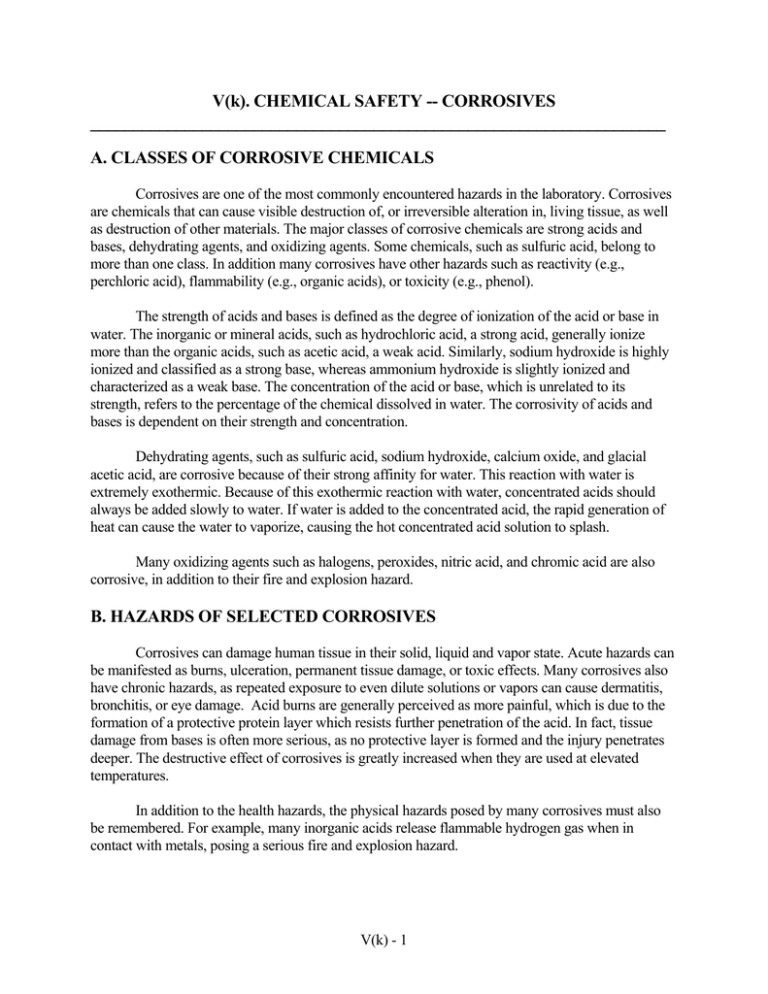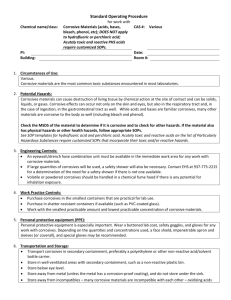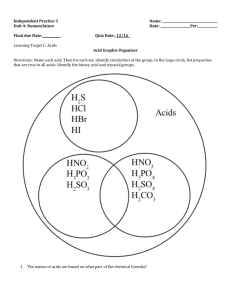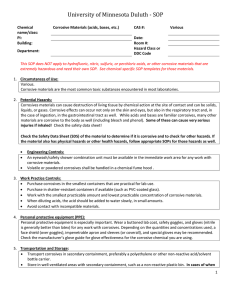V(k). CHEMICAL SAFETY -- CORROSIVES A. CLASSES OF
advertisement

V(k). CHEMICAL SAFETY -- CORROSIVES ___________________________________________________________________ A. CLASSES OF CORROSIVE CHEMICALS Corrosives are one of the most commonly encountered hazards in the laboratory. Corrosives are chemicals that can cause visible destruction of, or irreversible alteration in, living tissue, as well as destruction of other materials. The major classes of corrosive chemicals are strong acids and bases, dehydrating agents, and oxidizing agents. Some chemicals, such as sulfuric acid, belong to more than one class. In addition many corrosives have other hazards such as reactivity (e.g., perchloric acid), flammability (e.g., organic acids), or toxicity (e.g., phenol). The strength of acids and bases is defined as the degree of ionization of the acid or base in water. The inorganic or mineral acids, such as hydrochloric acid, a strong acid, generally ionize more than the organic acids, such as acetic acid, a weak acid. Similarly, sodium hydroxide is highly ionized and classified as a strong base, whereas ammonium hydroxide is slightly ionized and characterized as a weak base. The concentration of the acid or base, which is unrelated to its strength, refers to the percentage of the chemical dissolved in water. The corrosivity of acids and bases is dependent on their strength and concentration. Dehydrating agents, such as sulfuric acid, sodium hydroxide, calcium oxide, and glacial acetic acid, are corrosive because of their strong affinity for water. This reaction with water is extremely exothermic. Because of this exothermic reaction with water, concentrated acids should always be added slowly to water. If water is added to the concentrated acid, the rapid generation of heat can cause the water to vaporize, causing the hot concentrated acid solution to splash. Many oxidizing agents such as halogens, peroxides, nitric acid, and chromic acid are also corrosive, in addition to their fire and explosion hazard. B. HAZARDS OF SELECTED CORROSIVES Corrosives can damage human tissue in their solid, liquid and vapor state. Acute hazards can be manifested as burns, ulceration, permanent tissue damage, or toxic effects. Many corrosives also have chronic hazards, as repeated exposure to even dilute solutions or vapors can cause dermatitis, bronchitis, or eye damage. Acid burns are generally perceived as more painful, which is due to the formation of a protective protein layer which resists further penetration of the acid. In fact, tissue damage from bases is often more serious, as no protective layer is formed and the injury penetrates deeper. The destructive effect of corrosives is greatly increased when they are used at elevated temperatures. In addition to the health hazards, the physical hazards posed by many corrosives must also be remembered. For example, many inorganic acids release flammable hydrogen gas when in contact with metals, posing a serious fire and explosion hazard. V(k) - 1 V(k). CHEMICAL SAFETY -- CORROSIVES ___________________________________________________________________ The following are examples of some of the hazards of commonly used corrosives. The list is by no means exhaustive. The hazards of each corrosive should be thoroughly investigated prior to its use. Sulfuric Acid is a strong acid, a dehydrating agent, and an oxidizing agent when heated. As a dehydrating agent, it is highly water-reactive, generating tremendous amounts of heat on contact with water. It is very destructive to tissue and metals, and releases flammable hydrogen gas on contact with active metals (e.g, Rb, K, Ca, Mg, Al, Mn, Zn, Fe, Ni, Na). Fuming sulfuric acid is even more hazardous and produces extremely hazardous vapors. Nitric Acid is a strong acid and powerful oxidizing agent. It can release hydrogen on contact with most metals. Nitric acid is extremely corrosive and its vapors toxic. The vapors contain nitrogen oxides which can cause delayed respiratory distress, pulmonary edema (fluid in the lungs) and death. Nitrogen oxides can also be released as a reaction with metals. Fuming nitric acid is more dangerous than regular nitric acid, again due to the presence of nitrogen oxides. Fuming nitric acid is listed as an acute toxin in Chapter V(h). The Halogen Acids include hydrofluoric, hydrochloric, hydrobromic, and hydriotic acid. The corresponding acid gases hydrogen fluoride, hydrogen chloride, hydrogen bromide, and hydrogen iodide are very soluble in water; upon exposure to moisture on the body, formation of the acid occurs. All are strong acids and release hydrogen on contact with active metals. Hydrofluoric acid is extremely corrosive and attacks glass as well as metal. It is extremely dangerous in all concentrations. It causes severe, slow-healing burns, to tissue which may not be noticed for several hours. It can also cause severe and permanent damage to the respiratory system, including fatal pulmonary edema, and blindness. In addition to these corrosive effects, it can cause delayed systemic poisoning including depletion of tissue calcium and magnesium. It is listed as an Acute Toxin in Chapter V(h) and special handling instructions are included later in this Chapter. Perchloric Acid is a strong acid and at temperatures above 160oC a strong oxidizing and dehydrating agent. It may decompose explosively when heated; and if distilled, dried, or reacted with dehydrating agents or any oxidizable materials, the mixture may spontaneously explode. It forms flammable hydrogen gas on contact with many metals; and forms explosive metal perchlorates on contact with certain metals. Perchloric Acid is especially hazardous at concentrations above 70%. Acetic Acid is a severe irritant to the skin and eyes. Severe irritation can occur at 25 ppm, but eye damage can occur at lower concentrations. Glacial (100%) acetic acid causes severe eye and tissue damage, is a dehydrating agent, reacts violently with oxidizing agents, and has a flash point of 110oF. Phenol is a crystalline solid that adsorbs moisture from the air. In addition to being corrosive, it is highly toxic and readily absorbed through the skin in liquid or vapor phase. V(k) - 2 V(k). CHEMICAL SAFETY -- CORROSIVES ___________________________________________________________________ Sodium and Potassium Hydroxide are strong corrosives and often referred to as caustics, a term referring to hydroxides. They are both solids which readily absorb water; and can absorb enough water from the skin to cause severe injury if not washed off immediately. They are both dehydrating agents. They cause severe and permanent eye damage. At low concentrations, the sensation of irritation may not occur for several hours, and can result in severe ulceration. They are even more hazardous in heated solutions. C. LABORATORY USE OF CORROSIVES 1. Always investigate the additional hazards such as flammability and reactivity. 2. If only a small amount is needed, purchase in small quantities for easier handling and storage. 3. Purchase in plastic coated bottles when available. 4. Use a bottle carrier or some other means of containment when moving chemicals from the stockroom to the laboratory or between laboratories. 5. Store separately from incompatible materials. 6. Wear appropriate protective equipment, always including splash goggles. 7. Always add chemicals slowly, and always add acid to water. 8. Keep ignition sources away from inorganic acid spills which may produce flammable hydrogen gas on contact with metals, and from glacial acetic acid which is itself a fire hazard. 9. When neutralizing corrosives, never add a concentrated acid to base or a concentrated base to acid. V(k) - 3 V(k). CHEMICAL SAFETY -- CORROSIVES ___________________________________________________________________ D. SPECIAL PRECAUTIONS FOR PERCHLORIC ACID 1. Prior to use of perchloric acid at concentration greater than 70%, or involving heating of the acid above 160oC, you should consult with the Chemical Hygiene Officer. 2. The number of people using the acid should be limited to the extent possible, and all users should be familiar with the chemistry of the acid, its hazards, proper handling procedures and emergency procedures. 3. Direct flame heating or use of oil baths is prohibited. 4. Perchloric acid should never be used in areas where the material would be absorbed if spilled. 5. Perchloric acid should be purchased on an as-needed basis in small containers and must be stored separately from incompatible materials. 6. Prior to performing experiments using perchloric acid, disposal procedures should be defined. In general, concentrated acid should be stirred into cold water until the concentration in less than 5%, the acid should then be neutralized with an aqueous solution of sodium hydroxide, and the resulting neutral solution flushed to the sewer with a large quantity of water.1 7. Spilled solutions must not be allowed to dry. They should be neutralized and then soaked up with rags or paper towels. The area should then be rinsed with a large quantity of water. The wet rags or paper towels should be placed in a container, and the container filled with water and tightly closed. The container should be disposed of as hazardous waste.1 8. Refer to Furr A.K. (ed.), 1990. CRC Handbook of Laboratory Safety, 3rd Edition., and Schilt, A.A., 1979. Perchloric Acid and Perchlorates., for additional precautions. 1 Source: Furr, A.K. (ed.), 1990. CRC Handbook of Laboratory Safety, 3rd Edition. V(k) - 4 V(k). CHEMICAL SAFETY -- CORROSIVES ___________________________________________________________________ E. SPECIAL PRECAUTIONS FOR HYDROFLUORIC ACID 1. A written protocol is required for the use of hydrofluoric acid. The protocol must be submitted to the Chemical Hygiene Officer and reviewed with all laboratory faculty, staff, and students. Protocol requirements are described in Chapter V(h). 2. The number of people using the acid should be limited to the extent possible, and all users should be familiar with the chemistry of the acid, its hazards, proper handling procedures and emergency procedures. 3. When possible the acid should be purchased at the concentration to be used to avoid preparation of solutions. 4. Hydrofluoric acid should be purchased on an as-needed basis in small containers. 5. Always use in a functioning fume hood with the sash as low as possible and no higher than 15 inches. 6. Only use in a room equipped with an eyewash station and safety shower. 7. Keep ignition sources away from the area. 8. Wear chemical splash goggles, a face shield providing face and neck protection, neoprene or polyvinyl chloride gloves, and non-absorbent resistant clothing. 9. Dispose of protective clothing and wash thoroughly after each use. 10. Use only resistant equipment (e.g., polyethylene, teflon). 11. First aid procedures in Appendix V(k)-A must be posted in the area of use. Calcium gluconate, and Allied Signal’s “Recommended Medical Treatment for Hydrofluoric Acid Exposure” must also be available in the area of use. 12. Prior to performing experiments using hydrofluoric acid, disposal procedures should be defined. In general, waste acid should be collected as hazardous waste. 13. Spills should be contained and diluted with water, and the resulting solution neutralized with lime prior to disposal. 2 2 Source: National Research Council, 1995. Prudent Practices for Handling Hazardous Chemicals in Laboratories. V(k) - 5 V(k). CHEMICAL SAFETY – CORROSIVES ___________________________________________________________________ APPENDIX V(k) -A FIRST AID TREATMENT FOR HYDROFLUORIC ACID EXPOSURE First Aid Treatment for Hydrofluoric Acid Exposure For all exposures have someone call Public Safety immediately and inform them that someone has been exposed to HF and needs to be taken to the emergency room for treatment. Skin Contact Flush with cool water for at least 5 minutes. Apply 2.5% Calcium Gluconate get as soon as rinsing is stopped. Massage gel into site continuously until medical treatment is received. Eye Contact Flush eyes for at least 15 minutes, holding eyelids open to allow flushing of the eyes. Ice water compresses should be applied to the eyes during transport to the emergency room. Inhalation Remove to fresh air. Oxygen should be administered by ambulance personnel during transport to the emergency room. Ingestion Drink large amounts of water immediately. Do not induce vomiting. If available, milk, maalox, or mylanta may be given during transport to the emergency room. If possible, take the publication “Recommended Medical Treatment for Hydrofluoric Acid Exposure” and the concentration of the acid involved to the emergency room with you.


